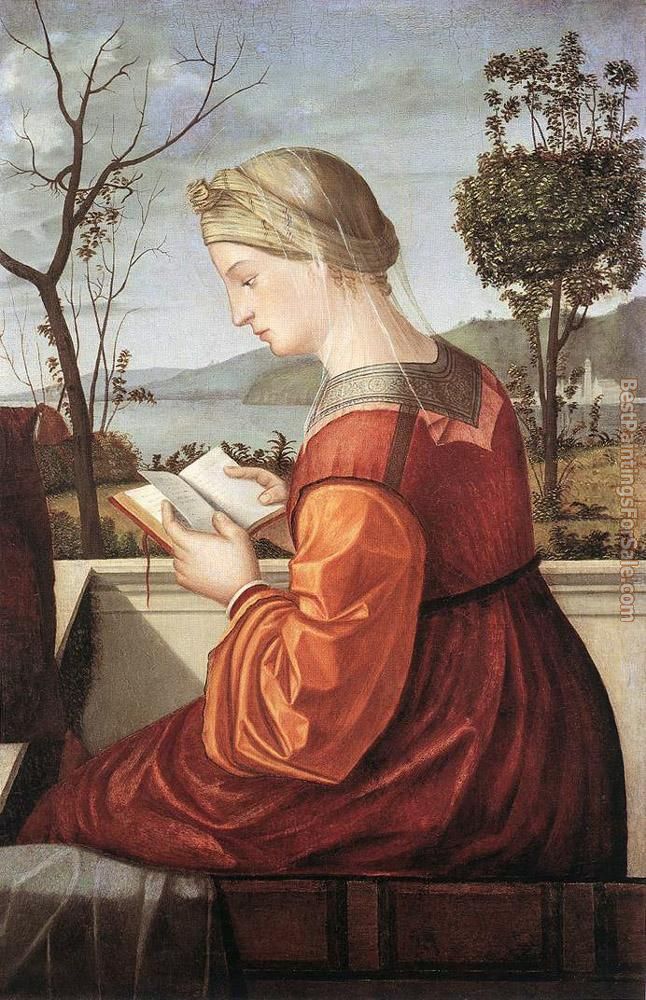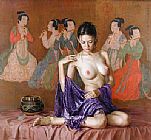Vittore Carpaccio Paintings for sale
Shop your favorite Vittore Carpaccio paintings and frames at discount price. We ship worldwide and accept custom art reproduction in any size.
oil paintings for sale > shop by artist > Vittore Carpaccio Paintings
- No. r2011
- Madonna and Blessing Child by Vittore Carpaccio paintings for sale
- Art price:from $98.01
- Select the size & frame

- No. r2012
- The Virgin Reading by Vittore Carpaccio paintings for sale
- Art price:from $98.01
- Select the size & frame
CARPACCIO, VITTORIO, or VITTORE (c.1465—c.1522), Italian painter, was born in Venice, of an old Venetian family. The facts of his life are obscure, but his principal works were executed between 1490 and 1519 and he ranks as one of the finest precursors of the great Venetian masters. The date of his birth is conjectural. He is first mentioned in 1472 in a will of his uncle Fra Ilario, and Dr Ludwig infers from this that he was born c.1455, on the ground that no one could enter into an inheritance under the age of fifteen but the inference ignores the possibility of a testator making his will in prospect of the beneficiary attaining his legal age. Consideration of the youthful style of his earliest dated pictures (St Ursula series, Venice, 1490) makes it improbable that at that time he had reached so mature an age as thirty-five and the date of his birth is more probably to be guessed from his being about twenty-five in 1490. What is certain is that he was a pupil (not, as sometimes thought, the master) of Lazzaro Bastiani, who, like the Bellini and Vivarini, was the head of a large atelier in Venice, and whose own work is seen in such pictures as the S. Veneranda at Vienna, and the Doge Mocenigo kneeling before the Virgin and Madonna and Child (formerly attributed to Carpaccio) in the National Gallery, London. In later years Carpaccio appears to have been influenced by Cima da Conegliano (e.g. in the Death of the Virgin, 1508, at Ferrara). Apart from the St Ursula series, his scattered series of the Life of the Virgin and Life of St Stephen, and a Dead Christ at Berlin, may be specially mentioned.Museum quality reproductions of Vittore Carpaccio paintings are available here.
Most Famous Vittore Carpaccio Paintings
Vittore Carpaccio Paintings for sale - Handmade Canvas Reproductions
based on 94 ratings.
- Shop by Art Gallery
- Gustav klimt
- Thomas Moran
- vincent van gogh
- Rembrandt Paintings
- John Constable
- Thomas Kinkade paintings
- Leroy Neiman paintings
- Frank Frazetta
- Pino Paintings
- Martin Johnson Heade
- Albert Bierstadt paintings
- Fabian Perez paintings
- Jack Vettriano paintings
- Alberto Pasini
- Alexander Helwig Wyant
- Alfred de Breanski
- Amedeo Modigliani
- Arthur Wardle
- Alexander Koester
- Alexandre Cabanel
- Andrew Atroshenko
- Benjamin Williams Leader
- Berthe Morisot
- Brent Lynch
- Cassius Marcellus Coolidge
- Caravaggio art
- David Lloyd Glover
- Edward Hopper
- Emile Munier
- Edward Henry Potthast
- Flamenco Dancer
- Franz Marc
- Frederick Morgan
- Francois Boucher
- George Armfield
- George Stubbs
- Henri Rousseau
- John Collier
- John Singer Sargent
- see more artists
new paintingsIn Stock Catalog
top selling
money back guarantee!- Daniel Ridgway Knight Knight Picking Flowers
- Albert Bierstadt Autumn in America Oneida County New York
- John Constable Salisbury Cathedral
- Mary Cassatt Poppies
- Louis Aston Knight A Bend in the River
- Thomas Kinkade Streams of Living Water
- John William Waterhouse Gather ye rosebuds while ye may
- Thomas Kinkade PARIS EIFFEL TOWER
- Jean-Leon Gerome Slave Auction
- browse more top selling
- ©2025 bestpaintingsforsale.com All Right reserved.






